|
| |
Photographic Competition Results
Health Basics: A supplement to Issue no. 22 - September 1985
pdf
 version of
this Issue version of
this Issue
|
There is much information in this issue that is valuable
and useful. Online readers are reminded, however, that treatment guidelines and health
care practices change over time. If you are in doubt, please refer to
WHO's up-to-date Dehydration Treatment
Plans.
|
Pages 1-4 Photographic Competition Results
A supplement to Dialogue on Diarrhoea Online
Issue 22 - September 1985
|
DDOnline
Photographic Competition Results supplement to DD22  Page 1 2
Page 1 2
PHOTOGRAPHIC COMPETITION
RESULTS Altogether you sent us 142 photographs from 18 countries. Your entries, along with the
descriptions of diarrhoeal disease control work in different settings, provide a unique
record of the fight against diarrhoeal diseases at 'grass-roots' level. As we had
expected, it was extremely difficult to select a winner and runners-up as the standard of
entries was very high. These four pages contain the photographs and project descriptions
from the runners-up. The winning entry from Dr A. A. Iliya from Zimbabwe is featured on
the front of="dd22.htm#page1">this issue of Dialogue on Diarrhoea. In alphabetical order, the runners-up are: Arif Ahamed, Bangladesh; Denice
Douwel,
Burkina Faso; Ole Hetta, Tanzania; K. Indirabai, India; M. U. Khan, Bangladesh;
Marie-Christine Lux, Peru; Rodrigo Manuel, the Philippines; Folasade Oyeladun, Nigeria;
Nalini Shakya, Nepal and Sonam Togbey, Bhutan. Since we were so impressed by all the
entries, as well as using them to illustrate future issues of DD, we have decided
to put together a special publication containing all the photographs and project
descriptions. When this is available we will publicize it in Dialogue on Diarrhoea.
Thank
you to everyone who sent photographs to us - we learnt a great deal about your problems
and successes and hope that other readers will enjoy sharing this information as well. Nigeria: nutrition training for mothers
| This photograph shows part of a training programme on nutrition
for breastfeeding mothers with particular emphasis on the types of food to use during
weaning. Role-playing helps to make the training more realistic and easier to understand.
Six specific roles are played; carbohydrate, protein, vitamins, fats and oil, water and
minerals. The woman playing the role of 'protein' introduces herself as the body-builder,
and explains that she replaces body tissues as a child grows and wards off infection. She
then shows the mothers examples of local foods that can supply protein such as bran, meat,
eggs, cowpeas, akara and moin-moin. |
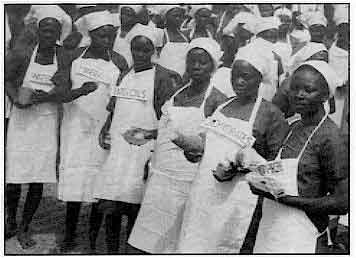 |
The woman playing the role of 'carbohydrate', explains that she supplies energy to the
body and helps to keep it warm. Locally available foods containing carbohydrates include:
eba, amala, iyan, yam, cocoyam, rice and bread. The main problem for local people is lack of money, so they are encouraged to start
small-scale gardening, and fowl-rearing so that they can have vegetables, fruit, chicken
and eggs. Mrs Folasade Oyeladun, State Health Education Unit, P. M. B. 4365,
Osogbo, Oyo, Nigeria. Bangladesh: ORT for adults too . . .
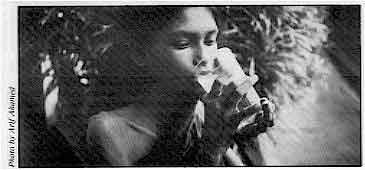 |
Oral rehydration therapy is the cheap, safe and effective method of preventing
and treating dehydration caused by diarrhoea. Children in particular need prompt treatment
because they dehydrate faster than adults - but ORT is equally effective in adults and
should always be encouraged. This woman with diarrhoea is drinking oral rehydration
solution. |
MD Arif Ahamed, c/o Studio Famous, Station Road, Sirajganj, Bangladesh.
|
|
DDOnline
Photographic Competition Results supplement to DD22  1 Page 2 3 1 Page 2 3
Nepal: breast to family diet
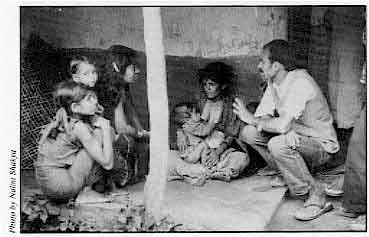 |
Breast
is best for infants, but not enough for those over six months of age. After six months
children need other food as well as breast milk. This photograph shows a malnourished
child who was receiving only breast milk at 15 months of age. Only two weeks before the
mother had started to give weaning food, consisting of soyabeans and wheat and corn,
taught by a village health worker. Unfortunately she did not have enough soyabeans and
pulses to feed the child over a long period so she started giving only corn porridge. |
It was a problem to encourage her to make, the more nutritious mixture, especially when
she explained that although after two weeks feeding the child was much better, she had no
pulses at home. A non-formal education facilitator from the CDAP suggested that she could
obtain soyabeans from him. The combined efforts of the village health worker, reinforcing
the feeding messages, and the CDAP have ensured that the child's life is not endangered. Nalini Shakya, Community Development Assistance Project (CDAP), UMN Post Box 126,
Kathmandu, Nepal. Bangladesh: health education essential
|
Clean water and good sanitation are essential components of any programme
aiming to prevent and control diarrhoeal disease. In this photograph latrines are shown
sited by the side of a river that is used by the local population for bathing, washing
clothes, fishing and water collection. Without health education, these people are unaware
that they can pick up diarrhoea pathogens while bathing in and through drinking the water
that contains faeces from the latrines. Dr M. U. Khan, International Centre for Diarrhoeal Disease Research, Dhaka 12,
Bangladesh.
|
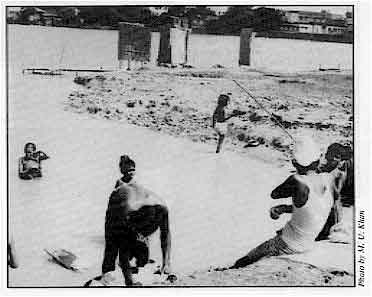 |
Philippines: better family health
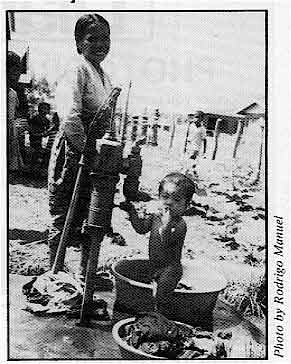 |
The availability of clean water from a pump such as the one shown in this
photograph can dramatically improve family health. Mothers no longer spend hours every day
fetching water and have more time to devote to their children, cooking more nutritious
food, growing vegetables etc. Personal and domestic hygiene is improved, and children like
this can safely play with the water without the danger of infection. |
Mr Rodrigo Manuel, Regional Health Office No. 12, ORC Compound, Cotabato City,
Philippines. The competition judges were the DD editorial team and Ms Stephanie
Simmonds, Coordinator of the Refugee Health Unit at the London School of Hygiene and
Tropical Medicine, currently Senior Health Co-ordinator at the UN Office for Emergency
Operations in Addis Ababa. Ethiopia.
|
|
DDOnline
Photographic Competition Results supplement to DD22  2 Page 3 4 2 Page 3 4
Tanzania: community participation
|
The Community Participation Health Education Project (CPHEP) is run jointly by
the Tanzanian government and NORAD and motivates villagers to participate in the
development of and to pay for village water schemes and sanitation programmes. The project
arranges village workshops and produces health education material suitable for use at
village level. This photograph shows women colouring flash cards, illustrating the causes
of diarrhoeal diseases, during a village health education workshop. Ole M. Hetta, CPHEP, P. O. Box 192, Sumbawanga, Tanzania.
|
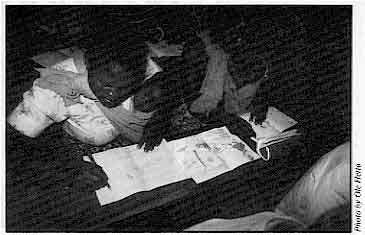 |
India: clean water supplies reducing diarrhoea
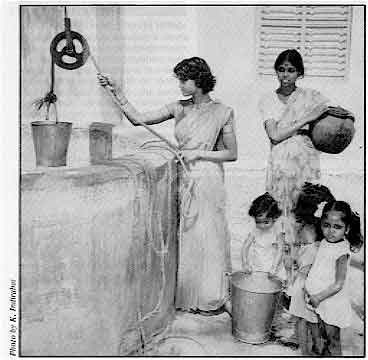 |
In the picture to the left, a young mother is drawing water from a
well in a rural area of Tirupati, Andhra Pradesh and tipping it into her bucket. Another
mother is waiting to collect water. The availability of clean water supplies, and proper
collection, storage and usage of water can do much to reduce high rates of diarrhoea. Professor K. Indirabai, Royal Commonwealth Society for the Blind, NAB Rustom
Alpaiwala Complex, 124-127 Cotton Depot, Cotton Green, Bombay 400033, India.
|
Burkina Faso: using visual aids
The Saboba Family Project includes many aspects of maternal and child health
care, including health education, growth monitoring, nutrition, gardening and tree
planting and animal raising. In this photograph villagers participate in a health
education session on malaria prevention, using visual aids prepared in Ghana.
Denice Kelin Douwel, s/c Les Peres Blancs, B. P. 5563, Ouagadougou, Burkina Faso. |
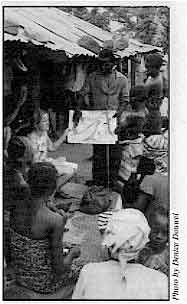 |
|
|
DDOnline
Photographic Competition Results supplement to DD22  3 Page 4 3 Page 4
Peru: integrated community development
| 'PROESA' is an innovative community development programme in the Peruvian
Andes. It focuses particularly on the improvement of local food supplies and the regular
employment of villagers near their homes in work such as weaving and carpentry. In Hualqui
village there is no safe drinking water. |
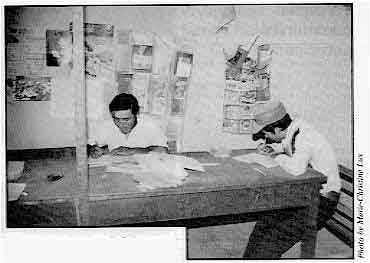
|
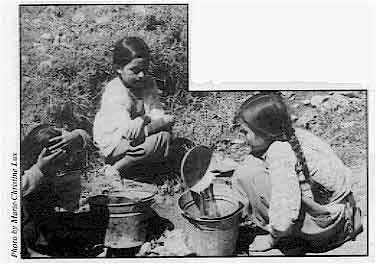 |
The photograph on the left shows children collecting water from a polluted
source. PROESA is encouraging the community to introduce various measures to improve the
quality of available water. Health promotors in Hualqui (see photograph above) are trained
in hygiene, first aid and disease prevention. Emphasis is placed on improved nutrition
using available resources.
Marie-Christine Lux, Apartado 8, Cajamarca, Peru
|
Bhutan: positive practices
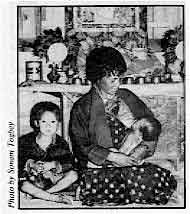
|
Yebilapcha
hospital in Shemgang, Bhutan, has 20 beds. The hospital runs a monthly mother and child
care clinic where the importance of oral rehydration therapy during diarrhoea is stressed.
Sometimes, children are admitted to the hospital with chronic diarrhoea. Sonam Tobgey
works as a laboratory assistant and is responsible for examining stool specimens. These
two photographs from Bhutan show a mother feeding her baby in front of the family altar,
and another mother giving oral rehydration therapy at home. |
|
The
mothers are shown how to make up the solution using boiled water. Luckily, Bhutanese
women do not starve their children when they have diarrhoea. Sonam Tobgey, Yebilapcha Hospital, Tingtingbhi P. O., Shemgang, Bhutan
|
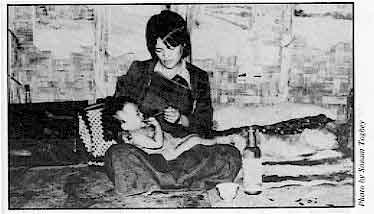 |
|
Photographic Competition Results
A supplement to Issue no. 22 September 1985
Page Navigation
This edition of Dialogue on Diarrhoea Online is
produced by Rehydration Project.
Dialogue on Diarrhoea was published four times a year in English,
Chinese, French, Portuguese, Spanish, Tamil, English/Urdu and Vietnamese and
reached more than a quarter of a million readers worldwide.
The
English edition of Dialogue on Diarrhoea was produced and distributed by
Healthlink
Worldwide.
Healthlink Worldwide is committed to strengthening primary health care and
community-based rehabilitation in the South by maximising the use and impact
of information, providing training and resources, and actively supporting
the capacity building of partner organisations. - ISSN 0950-0235 Reproducing articles
Healthlink Worldwide encourages the reproduction of
articles in this newsletter for non-profit making and educational uses. Please
clearly credit Healthlink Worldwide as the source and, if possible, send us a copy of any
uses made of the material.
|
updated: 4 March, 2016
updated: 4 March, 2016
|
version of this Issue